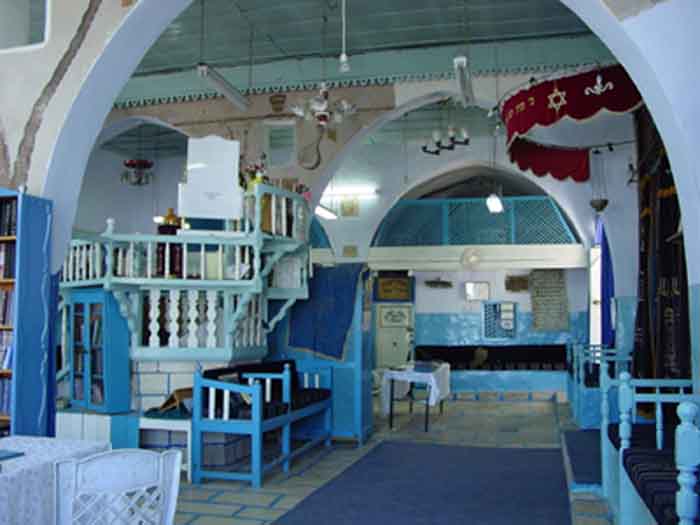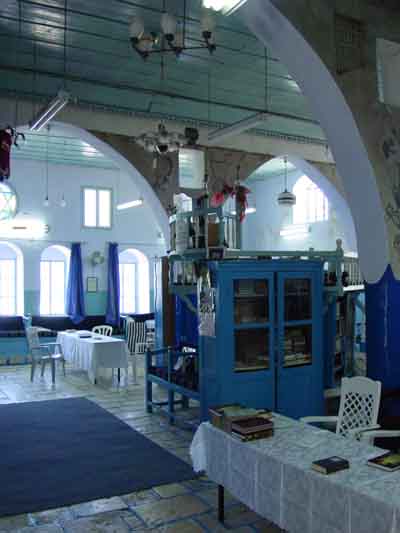by Chana Katz
Many a synagogue in the Holy city of Tsfat has been named after a righteous sage who prayed there, but this one, uniquely, was built on top of the very grave of its name-bearer, R. Yosi Bannai.
R. Bannai was a Talmudic-era sage who studied under Rabbi Akiva along with great Torah luminaries such as Rabbi Shimon Bar Yochai. His grave is located right under the synagogue’s second-floor women’s section. Hundreds of folded notes with heart’s desires and prayers have accumulated on the elevated, cement-covered resting place.
The Miracle Of The Roosters
Interestingly, the synagogue of R. Bannai is best known by another name — The Shul of the Tzaddik HaLavan (the white saint). It may come in handy if you’re looking for it and get lost along the charming, narrow cobblestone roads that lead to it. Ask for the “Tzaddik HaLavan” and most locals will point you in the right direction.
Its name comes from a famous story that has become legend in these parts, from the time under Turkish rule of the Ottoman Empire.
A particular Sultan made life pretty miserable for the Jews of Tsfat. One time he went so far as to decree that the Jews bring him hundreds of white roosters or face death.
The Jews were heartbroken and fearful. How could they ever fulfill such an impossible demand? Their roosters were brown or black or shades of other colors. Where could there possibly be hundreds that were white?!
Stricken with panic and fearing the worst, they went to the outskirts of Tsfat, where they poured out their hearts at the gravesite of the beloved sage, R. Yossi Saragossi. Bearing the distinction of having become the city’s first elected chief rabbi recorded in history, in 1490, R. Saragossi’s Torah wisdom and impeccable character traits had won him the respect of the areas Jews and its non-Jewish dwellers as well. After fervent prayers for help at the holy place, they returned to Tsfat where they prayed and fasted –some say for three days– at the Bannai synagogue.
The night after, R. Saragossi came to one of the congregants in a dream and told him to tell the Tsfat Jews to bring hundreds of roosters to his gravesite — and never mind that they weren’t white!
They did, and as the story goes, a miracle occurred. All the roosters turned white. The site of hundreds of noisy, white roosters being delivered at the Sultan’s doorstep made a deep dent in the Turkish ruler’s psyche. After that, the Sultan realized that the Jews were a special people and he relaxed his cruel decrees.
And the synagogue best became known as the Tzaddik HaLavan.
A Glimpse Behind The Iron Doors
One of the three oldest synagogues in Tsfat, Bannai hovers over one of the newest houses of prayer on the block — the Breslover Synagogue. You can find it by winding down HaAri Street until you come to the Kadosh Machlevah (Kadosh’s cheese factory) and ascend the narrow lanes to Bannai. (There is also a staircase approach from the top of it about two levels down from the Abuhav Synagogue on Yud-Alef Street).
The entrance is a simple, blue rusting iron door with carved Stars of David. But don’t let its looks be deceiving. It is but a mere passageway to a courtyard shaded most generously by a splendidly sprawling fruit tree. The courtyard leads to a small room, which upon a time was used by the kabbalists of the day to study the fiery secrets of the Torah. Today it is used for an occasional second prayer minyan, children’s afternoon learning groups and for hospitality.
Another door leads to the main synagogue itself, which is surprisingly spacious. Its design resembles that of other synagogues built in this era. Estimated at about 500 years old, it has both age and grace.
Cement-covered stone seats with colorful cushions that run the entire length of its walls, as was the custom for synagogues of that period. The elevated bima (Torah-reading platform) is located in the center, next to the “seat of Eliyahu” — a large chair for the person given the honor of holding the baby during a ritual circumcision and a small, adjoining wooden crib for the newborn.
Among the more “modern” features of this synagogue are the painted etchings of biblical instruments, such as King David’s harp, on the ceiling’s supportive arches. An artist was retained to make this addition to the synagogue about 100 years ago.
All In The Family
The Shababo family, which lives only minutes away, has been taking care of the synagogue for most of the past 400 years. The keys have been guardedly passed down from one generation to another, with family members serving in the position of shamesh, or caretaker.
Rebbetzin Miriam Shababo, the wife of the Bannai’s current caretaker, Yosef Shababo, said her father-in-law, of blessed memory, had served in this post for some 80 years. The family is strongly opposed to turning control of the synagogue over to the Tsfat municipality, even though that decision has kept it from receiving any government funding.
Accordingly, Rebbetzin Shababo said, the family also made a decision to keep the synagogue closed to the public after some visitors brought some unsavory books there once. But if a visitor does want to tour Bannai, Rebbetzin Shababo said they can contact her, and, for a small donation toward the synagogue’s upkeep, it can be opened. Her phone number is (04) 697-4086.
Of course, one can also visit the synagogue during the Sabbath prayers. Between 40 and 50 men gather then, mostly elderly regulars who walk from distances around Tsfat just to maintain this special minyan.
History Was Made Here
While the prayer minyans and Torah learning may seem routine today, the walls of this synagogue bear witness to one of the most exciting moments in halachic (Jewish legal) decisions.
The year was 1538 and a bold sage named Yaacov Berav, at the time the chief rabbi of Tsfat, decided to re-institute “semicha” — genuine rabbinic ordination — which had first been conferred upon Moshe Rabbeinu at Mt. Sinai and continued to the end of the Babylonian academies in the fourth century.
Rabbinic ordination of this caliber gave the ordained rabbis the strength and power to carry out Torah-based judgements, the likes of which are not known today.
Berav’s decision was met by fiery opposition from Jerusalem’s circle of rabbis. The latter scorned and fought the move by their Galilee counterparts, in what had already become a rivalry between the two Holy cities over who bore the ultimate crown of holiness..
Berav persisted and in one historic moment, at the Bannai Synagogue, Berav was unanimously ordained by the rabbis of Tsfat, and he, in turn, ordained his other esteemed peers who were some of the most important Rabbinical figures in Jewish history — R. Yosef Karo (author of the Code of Jewish Law), R. Moshe Metrani, R. Moshe Galante and R. Moshe Cordovero.
The opposition to this move didn’t abate, however, and after a brief 50 years, the semicha was discontinued and R. Berav died in a bitter exile.
The Lag B’omer Parade
But another tradition stemming from this synagogue, one begun 172 years ago, still continues to this day.
Every Lag B’ Omer, when Jews from all over the world head toward Meron to celebrate the day Rabbi Shimon Bar Yochai’s soul left his body for the unbounded upper worlds, a certain group of Tsfat residents also join the throngs headed to Meron. Their annual visit to Meron begins with a colorful, enthusiastic parade in which they carry a Torah scroll down Tsfat’s main road, Jerusalem Street.
And guess where this Torah is housed! The Bannai Synagogue. It was donated some 175 years ago in the memory of Rav Shmuel Chai Abbu, whose charitable family aided many poor community residents and victims of the devastating earthquake of 1837. The Abbu family also gave a generous amount of funds to build up the Meron site.
Yosi The Builder
With such a colorful and lofty history of the synagogue that bears his name, one wonders about the nature of this Tanna — Mishnaic-period sage — who was buried high on the western slope of Tsfat during the Roman rule.
Actually, despite his great knowledge in Torah and philosophy, he was also, as his last name implies, a simple builder.
A story relates that one time a gentile philosopher asked how the earth was originally created.
“Go ask Yose the Builder,” he was told.
When the philosopher approached R. Bannai, the sage refused to come down from his scaffold.
“I cannot descend (from the scaffold) because I was hired to work by day. But ask (your question),” he said, as he continued working.
The philosopher asked and R. Bannai replied, “G-d took dust from beneath the Throne of Glory, and cast it into the water where it became earth and the little pebbles that were in the dust became mountains and hills.”
And on one of those hills in the Galilee mountains of Tsfat, lies the resting place of R. Bannai and the house of prayer that was built in his honor.
Buy books about Safed and the ancient masters of Kabbalah at the Kabbala Online Shop.
Chana Katz, a former South Florida journalist, lives in Tsfat. Her articles on life in Israel have reached publications throughout the world.


